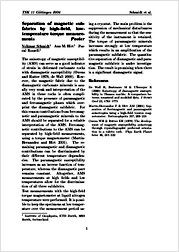Separation of magnetic subfabrics by high-field, lowtemperature torque measurements
Schmidt, Volkmar
Hirt, Ann M.
Rosselli, Pascal
Universitätsverlag Göttingen
Sammelband- / Konferenzbeitrag
Verlagsversion
Deutsch
Schmidt, Volkmar; Hirt, Ann M.; Rosselli, Pascal, 2006: Separation of magnetic subfabrics by high-field, lowtemperature torque measurements. In: Philipp, S.; Leiss, B; Vollbrecht, A.; Tanner, D.; Gudmundsson, A. (eds.): 11. Symposium "Tektonik, Struktur- und Kristallingeologie"; 2006, Univ.-Verl. Göttingen, p. 196., , DOI: 10.23689/fidgeo-1877.
 |
Dokument öffnen: |
The anisotropy of magnetic susceptibility
(AMS) can serve as a good indicator
of strain in deformed carbonate rocks
with diamagnetic susceptibility (Owens
and Rutter 1978; de Wall 2000). However,
the magnetic fabric due to the
diamagnetic carbonate minerals is usually
very weak and interpretation of the
AMS in these rocks is often complicated
by the presence of paramagnetic
and ferromagnetic phases which overprint
the diamagnetic subfabric. For
this reason contributions from ferromagnetic
and paramagnetic minerals to the
AMS should be separated for a reliable
interpretation of the AMS. Ferromagnetic
contributions to the AMS can be
separated by high-field measurements,
using a torque magnetometer (Martin-
Hernandez and Hirt 2001). The remaining
paramagnetic and diamagnetic
contributions can be discriminated by
their different temperature dependencies.
The paramagnetic susceptibility
increases as an inverse function of temperature,
whereas the diamagnetic part
remains constant. Altogether, AMS
measurements at high fields and low
temperatures allow for the discrimination
of all three subfabrics.
Test measurements with the high-field
torque magnetometer at liquid nitrogen
temperature were performed. It is possible
to keep the specimens at low temperature
over the measurement period using a cryostat. The main problem is the
suppression of mechanical disturbances
during the measurement so that the sensitivity
of the instrument is retained.
The torque of paramagnetic minerals
increases strongly at low temperature
which results in an amplification of the
paramagnetic subfabric. The quantitative
separation of diamagnetic and paramagnetic
subfabric is under investigation.
The result is promising when there
is a significant diamagnetic signal.

